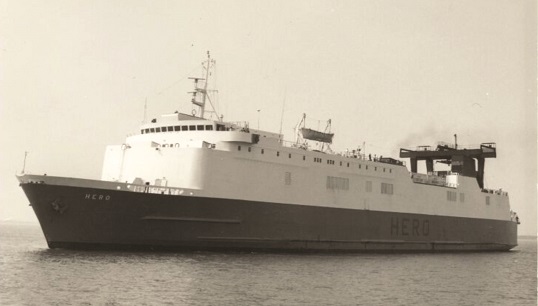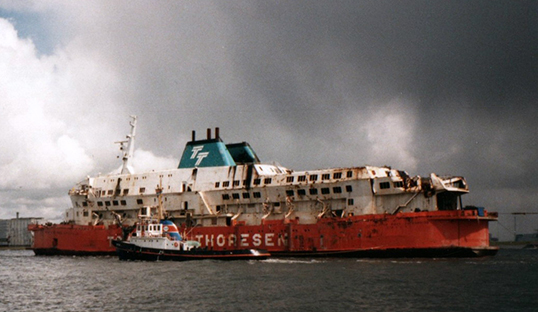Hero

The build
The 4,493grt vessel was built at the Rob Caledon yard in Leith, Scotland in 1972. Hero was powered by two Crossley-Pielstick diesel engines and had a designated service speed of 17 knots.
Originally of 3,468grt, Hero had its gross tonnage increased by just over 1,000 tonnes during structural alterations at the Amsterdam Dry Dock Company in 1976, which also lengthened the vessel by 24.5m and lifted the container deck.
Deployments
Managed by Ellerman Wilson Line of Hull, Hero operated what the inquiry into the loss described as 'the hard running trade of a continuous ferry service,' making a round trip every four days between Esbjerg and Grimsby, or occasionally Harwich or North Shields.
Ownership
Hero was jointly owned by DFDS and Domino Container Ships.
Hero Fact File
When did the Hero sink?
Hero was lost in 1977 in heavy weather, prompting Union concerns about the safety of ro-ro vessels
How much did Hero weigh?
Hero had an original grt of 3,468grt which was increased to 4,493 in 1976
How many survivors were there?
All but one of 27 crew and three passengers on the Hero survived
A close call
One year before the ship sank, it was involved in a serious incident when water flooded into the lower trailed deck through non-return valves after an 18-degree list developed following a shift of cargo in heavy weather.
Disaster was averted by a change in the weather and allowing the water to flow into the engineroom, from where it was pumped overboard.
Sinking of the Hero
The same technique used during the first incident was used on the night of 13 November 1977, when the Hero was on its regular run between Esbjerg and Grimsby. Water flooded the same deck as a result of what the inquiry later determined to be heavy weather damage to the forecastle deck and the stern doors in Force 10 to 12 conditions.
However, this time the technique was less successful, and the incident led to the death of a seafarer. The rest of the 26 crewmembers and three passengers were rescued by two other merchant vessels and a Canadian warship after they abandoned the listing ferry.
Union concerns
Hero's master Captain Frederick Firth and chief officer Guy Snowden were exonerated from any blame by the subsequent Department of Trade investigation. It ruled that the shop had been in breach of its loadline assignment and was unseaworthy because of shortcomings in the condition of the stern doors and superstructure.
However, the Nautilus predecessor Union MNAOA described the inquiry report as disappointing because it made no attempt to question the inherent seaworthiness of ro-ro ships.
The Union expressed particular concern about their ability to cope with a sudden ingress of water into enclosed spaces and its national ferries committee set up a working group to consider the wider issues of ro-ro safety.
The MNAOA working group concluded that it was wrong that the Department of Transport requirements for ro-ro ships were based on conventional vessels, and it said the rules should be altered to reflect their high decks, low freeboards and large open spaces.
The Union took part in subsequent discussion on the issues with owners, naval architects and regulators, but sadly it was to take the sinking of the Herald of the Free Enterprise and the deaths of 193 passengers and crew in 1987 before any significant changes were made to ro-ro design in an attempt to mitigate the threats posed by the 'free surface effect' of water flooding vehicle decks.


Contribute
Are you knowledgeable about this vessel?
Submit your contribution to this article to our editorial team.
Write to usView more ships of the past
HMS Beagle
Launched 200 years ago, HMS Beagle has been described as one of the most important ships in history – thanks to the observations on evolution and natural selection that its famous passenger Charles Darwin made during a five-year voyage around the world between 1831 and 1836.
Common.ReadMoreHMS Beagle
Megara
Originally constructed as an oil tanker in 1929, the Dutch ship Megara went on to become one of the first specialist liquefied petroleum gas (LPG) carriers only five years later.
Common.ReadMoreMegara
Esso Ulidia
Delivered in October 1970, Esso Ulidia was one of eight 250,000dw-plus ships, which were all named after old British and Irish kingdoms, to be constructed for Esso's red ensign fleet between 1969 and 1973.
Common.ReadMore